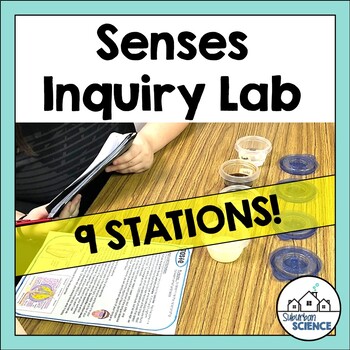Five Senses Lesson Inquiry Lab Activity - Senses Stations for High School
What educators are saying
Also included in
- Looking for anatomy resources to fit the laboratory portion of a high school Biology or Human Anatomy course? This Anatomy and Physiology bundle contains 34 thorough and engaging activities for hands-on learning! The labs and activities included in this bundle are designed to be easy to use and alPrice $85.00Original Price $117.00Save $32.00
Description
This 9-station student-directed lab is a great low-prep activity for Anatomy or upper-level Biology students to learn about the anatomy and physiology of the senses including hearing, vision, touch, balance, taste, and smell. Student instructions, lab worksheets, and diagrams are all included.
*Student worksheets are now also included in digital format for use in Google Classroom or any other online platforms that use Google Slides.
Senses and terms addressed:
Touch- Two-point discrimination, free nerve endings, hair follicle receptors, Pacinian corpuscles, Ruffini's corpuscles, Merkel's disks, Meissner's corpuscles, thermoreceptors, accomodation
Smell- Olfactory epithelium, olfactory bulb, cilia, accomodation, olfactory fatigue
Taste- Gustation, papillae, filiform, fungiform, foliate, circumvallate taste buds
Vision- rods, L-cones, M-cones, S-cones, dichromacy, sex-linked trait, blind spot, cornea, aqueous humor, lens, fovea centralis, retina, hyperopia, myopia
Hearing- ear drum, malleus, incus, stapes, frequency of sound, age-related hearing loss
Balance- endolymph, semicircular canals, relationship between vision and balance
*PLEASE NOTE: This resource is also included in my Nervous System and Full Human Anatomy and Physiology Curriculum.
Included in this resource:
-1 page of teacher directions w/ set-up and materials list
-9 stations for testing physiology of senses (background information and procedures are provided for each station)
*See the PREVIEW link above for specific information about each station
-Diagrams for additional information
-1 student packet with discussion questions for assessment of understanding (printable and digital versions included)
Answer keys
Teaching about all systems of the human body? Here is a listing of all my Human Body resources:
Introduction to the Human Body (FREEBIE!)
Reproduction & Human Development
Human Body Systems PowerPoint Bundle (just PowerPoints & notes)
________________________________________________________________________
⭐For updates about sales and new products, please follow my store: My TpT Store
You can also
⭐Subscribe to my newsletter for freebies and teaching tips
⭐Follow me on Instagram
⭐Check out my Facebook page
⭐Follow me on Pinterest
I value your feedback. Please rate this product. If you have any issues or questions about this product, please feel free to ask a question in my store or write to me at support@suburbanscience.com.






